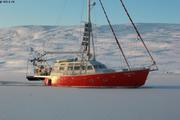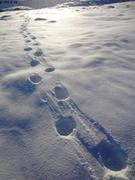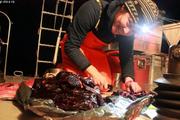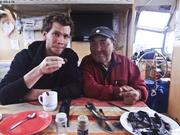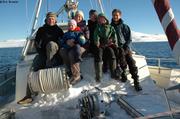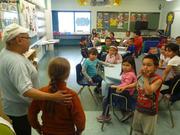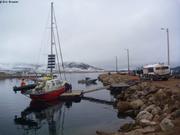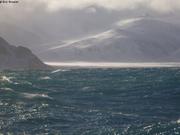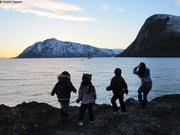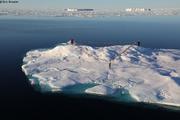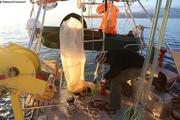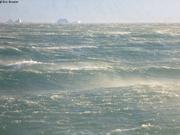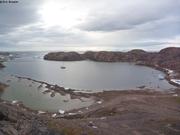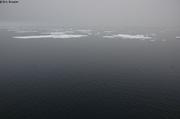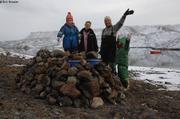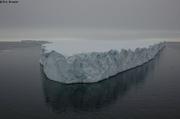Blog
Harmony
The polar bear and narwhal hunting seasons are over for this year in Qikiqtarjuaq. Inuit people are the only one allowed to hunt those two species, following a very precise regulation. Only a few of those animals can be hunted each year and the hunters are designated by drawing lots. A conservation officer, who came on board, makes sure the rules are respected. The meat which feeds the community is shared among its members, the skin is recycled into mittens, boots or sometimes sold. Nothing is wasted when it comes from the animal. This subsistence hunt is fully part of the inuit culture, it is based on an immense knowledge of the available ressources and it is done respecting the land and the environment that have fed them for thousands of years. In fact, no one should make fun of the polar bear, they hear everything!
As they caught the last narwhal and butchered the last polar bear, there are less boats going back and forth in the bay, the engines are now silent, only few more hunters looking for seals. Some unsuccessful hunters are coming on board Vagabond for a little break, to enjoy our tea or coffee that have now an excellent reputation in town. It is a great opportunity to chat a bit. Friendship is quite easy, we already spent time with a few families in the village, each of them very nicely inviting us for a shower, a coffee, or just for sharing a moment… People are telling us how families from Kivitoo and from Padloping Island have been moved here in order to build the Fox-5 DEW Line station and therefore create Qikiqtarjuaq in the fifties. Some of them keep very bitter and vivid memories of that relocation, blaming the government for burning their houses and killing their dogs. In this new village, they had to recreate everything from scratch, organise themselves for their groceries by doing trips to Pangnirtung with dog-sleds, an epic journey through the famous Pang Pass that was taking several days.
Meanwhile, there are more and more polar bear tracks on the shore close to the boat. During one of our walks, we saw briefly a young male feeding on a narwhal carcass. November will be their month, simultaneously with the sea ice formation and the beginning of the polar night. The sun is not high in the sky any more (less than 10° above the horizon), offering us some amazing grazing lights on the top of the mountains. Qikiqtarjuaq is getting ready for the winter.
Narwhals in October
It is a great pleasure to temporarily replace Eric, France, Léonie and Aurore on Vagabond for a few months. “I hope you know how to do everything well by now?” asked us Léonie before she left. We are now all set and our daily life is at the same pace as life in the north.
October is a month of narwhal and polar bear hunts in Qikiqtarjuaq: every day, a dozen of hunters’ boats are on the water to look for the sea unicorn. There was seven left on the yearly quota when we arrived, there is only one left today. The whole village breathes with the hunters. Three narwhals were caught close to the boat, we joined the hunters’ team when they got to shore and watched them cut up the carcasses long after sunset. Six boats, a dozen of men and women of all ages busy around the three whales, cutting up maktak (skin and 1cm of blubber) and the meat; “we leave the rest for the polar bears – very skinny those days – or for other people from the village that have dog teams”. The way the meat is divided tells a lot on the way of living here: once the close family and relatives of the main hunter have enough, he then invite through the local radio station all the community members to come and help themselves at his place. A little bit for everyone, always thinking of the ones in town that have less to eat.
The village have the right to hunt five polar bears this fall (total quota per year is ten). The hunters get their names picked up, a few are chosen by chance every night. Once the meat is all ready and divided, they start to prepare the skin, huge task that we witnessed during an evening night at some friends in town.
Each visit to the village allows us to meet a little more the community members, exchange and share with them. “Do you know Léonie?” are asking us her school friends. They are intrigued by this boat that will stay all winter! We now have visits on board, we share a coffee, having conversation in English or in Inuktitut always helped by the famous international sign language!
Hunting season will be over in the next few days, and it will start again in January with potentially a few more polar bears.
New crew
Valentine and Vincent arrived Thursday in Qikiqtarjuaq, they are now ready to look after Vagabond during our three-month absence. For the past two and a half years, we spent only two months in France. We're a little nostalgic to leave this beautiful area, especially in this season, but very happy to soon meet with our families, friends and partners. Some festivals and talks are planned.
Vagabond is ready for winter, it is -8°C this morning, but the ice not expected to form before next month (the sea is already frozen in Grise Fiord). We had beautiful weather for the last few days, and Aurore discovered her first northern lights! A camera has been set up for nine months, it should take a picture of our wintering site every hour... Hunters are visiting us from time to time, Vagabond is three kilometres away from the village. Saturday, some of them were curious to learn that narwhals just passed. Another hunter came yesterday to give us a big Arctic char!
There was a great day of celebration last Tuesday, on the thirty-three years anniversary of Qikiqtarjuaq (it was previously a settlement). It allowed us to meet a good part of the community, and to answer many questions from the villagers. Sam, Mary's husband (Mary is the Mayor in Qikiqtarjuaq) was thrilled to receive a muskox hide that we brought from Grise Fiord from his mother Minnie. On the phone, she told her son that "it looks empty without Vagabond".
Setting up in Qik
Qikiqtarjuaq, about 500 inhabitants, very welcoming. We arrived on Tuesday night, not even one week after leaving Grise Fiord. The last night of sailing was quite long: front wind (light), swell from offshore, darkness due to clouds, and the radar couldn't detect icebergs because it was snowing. At last, we found the little bay we were aiming to, 3 kilometers from the village, despite usual imprecision of the charts in these regions hardly visited.
Last Sunday in Clyde River, we had a few nice encounters, and we met Bob Shepton and his crew on board Dodo's Delight. There was about thirty boats in the North-West Passage this summer!
Qikiqtarjuaq is built on Broughton Island, near the huge Baffin Island. During the last very recent count, fifteen bears were seen on the little island! The population is increasing since hunting has stopped, we have been quickly warned about it. Many narwhals too, the hunting season has just finished when 26 were caught last Thursday (out of 70 per year, total quota). All boats were out of the little harbour, so it was the perfect time for Vagabond to come in to get diesel and water! Léonie is going to Inuksuit school since Wednesday, Aurore found the house for "Parents and Tots", both of them are very happy to have new friends. With many gifts from our friend nurse in Grise Fiord, who has been leaving here for five years, we are gradually meeting with people in Qik.
What a comfort to have a real good shelter so close to town! Before freezing, when the sea is calm, we can go to town using our dinghy in about twenty minutes, or we can move Vagabond and temporarily drop anchor in front of the little harbour.
Full moon and high
Vagabond is half way between Grise Fiord and Qikiqtarjuaq (1200km). It's the equinox, France and I have as much night than day watches. Winter is coming early this year, but luckily a nice high set up on our route. The full moon and the sun are allowing us to better see icebergs and admire the very snowy coast of Devon, Bylot and Baffin Islands. Fair or light winds are significantly reducing freezing sprays!
At least, France and I could go ashore in Grise Fiord on Tuesday morning, where we met with Aurore and Léonie, well surrounded. While France was making our entry to Canada official, with Ed and Patrice from the Royal Mounted Police, I was climbing the nearby mountain to pick up the third and last camera. A young dog followed me all the way, sometimes a bit scared in the snowy slopes! In the evening, when it was getting dark, it was time to set sails. Again, many friends came to the shore, this time to say goodbye to each other. A lump in our throats. Two years of sharing, hard to turn over a new leaf.
Yesterday morning, our little family crew woke up at anchor, shelterd by Cape Bathurst (Bylot Island), rested. A polar bear walked on the beach, peacefully. Not long after, Vagabond met her own track from ten years ago, while sailing around the Arctic.
Tomorrow, we will stop in Clyde River, the only village on our way.
Goodbye South Cape Fiord
"Léonie ! Léonie ! Léonie !", were chanting her friends while we were approaching the beach by dinghy. Many of our friends from Grise Fiord were here, Saturday evening, to welcome us on our return from Greenland. A little tired after the trip from Qaanaaq, we were all the more moved. Happily we had fair winds, but heavy swell and broken down autopilot. France fall on her head, of no consequence but an unscheduled stop at Carey Islands. Magnificent archipelago, totally uninhabited, but better sheltered than expected, perfect to get some rest. As for Léonie (6) and Aurore (3), they have been in great shape all along the crossing from Greenland to Canada! And they are delighted to be in Grise Fiord since, welcomed by Joanne, the nurse.
France and I left straight away for South Cape Fiord, five hours further. Exceptional weather gave us a chance to accomplish a few missions, and to say goodbye to our unforgettable wintering location (2011-2012). After a short night at anchor, we first had to climb the nearby pyramid to recover two cameras, set up with Christian Haas in May. Little snow after all, very practicable terrain, and a beautiful view. No wind and sunshine, we stayed more than one hour at the summit. Then we couldn't leave the area without doing a CTD in the middle of the fjord, at the usual place. Also two lines of soundings, still looking for more explanations on specific exchanges happening between this fjord and the ocean. Sampling plankton in the end, and we were heading back to Grise Fiord, happy after this little week-end just two of us!
Wind and swell is keeping us on board since last night, we are looking forward to go ashore to see again our friends before sailing South.
From Marshall Bay to Qaanaaq
September 6. Waiting for high tide to raise the anchor, we enjoy again the sun for a picnic ashore. But it is time to sail south. Ice came close to the coast with the south-west wind. The light is beautiful. In support of its awareness message about Arctic lusts, Emmanuel with Catherine and Bénédicte are deploying 193 colourful flags on a nice ice floe. Vagabond is sailing around them to capture images of that symbolic moment. Emmanuel, committed writer, will send later his message to all countries. As expected, fog is coming and wind is picking up around one in the morning, Vagabond drops anchor near Littleton Island, in a small bay that dries up almost entirely at low tide! On land, we are still seeing a lot of remains of stone huts.
The next day the wind is still blowing hard when we seek an anchorage for exploring the island of Littleton. Having sailed all around, a part of the team manages to land in search of traces left by the explorers of the last century. Unfortunately the snow is hiding most of it, only the large cairn at the top of the island is easy to access. Again, we find a bottle and a message left by the crew of Dagmar Aaen, 4 years ago. Eric can still inspect the weather station repaired two years ago. The wind is strong, very strong at the top of the island. Vagabond is pushed by the wind, she quickly moves on to the nearest shelter, Kenrick Bay, waiting to pass the famous Cape Alexander. The wind dies down the following day, the road is radiant along the snowy coast. So quiet that the plankton net is launched, tiny and very red bodies are going crazy at the bottom of their bottle! In the night Vagabond drops anchor a few hours from Qaanaaq, one day ahead of the plane's departure of our friends.
Aurore and Eric are going ashore, splendid weather, while the rest of the team is sleeping in. But later, the ultimate picnic trip is suddenly cut short by severe storms. We rush to the beach as soon as possible. The sea, glassy before, is already rough when we are going back to Vagabond by dinghy. Very quickly, we get forty then fifty knots of wind, then sixty, even sixty five knots in gusts! The anchor doesn't hold, the sea is white, bits of icebergs are passing quickly nearby... We have to use the engines, all afternoon, to avoid drifting. Some worries, children's stories, everyone keeps busy on board, also admiring the sight outside, while tacking on the spot! The next morning the wind finally calm down, the anchor has drifted for 800 meters! Vagabond has just enough time to sail to the airport to drop off the team, without even going through the village.
Alone again, all four of us are going to visit Hans and Birthe, enjoying the nice weather, on land. By a happy coincidence we meet Marius and Naja, we were so warmly welcomed at their home in Savissivik two years ago. And we are disappointed that we cannot accept their invitation, since we're on the start, the weather window can not wait!
Out of the ice
The Fram Bay is a protective trap, Vagabond could spend the winter there... The ice pack is drifting through Rice Strait since yesterday (September 1st) and we decide to try to follow it, heading south. Right out of the bay we are carried on a kind of conveyor belt which carries aggressive floes, thick, with little room for sailing. Not to mention the little headwind pushing Vagabond on an edge of the narrow strait. When movements are decreasing, it is because the channel is filled up, the ice is embedded in a giant puzzle. A too high floe just stamp the back of Vagabond already locked, bending the cable holding the mast under the rear platform... Fortunately, it simply deforms under pressure.
We struggle to avoid over exposing the hull, and less than one nautical mile is covered in half a day! After an hour of respite, to our surprise, the current is reversed, this time we try to go back to the north. Quickly reaching the exit of the channel, we finally discover a channel of open water along Pim Island, we are out of the trap! We are passing Clay camp, but there is too much snow to watch. In addition, a large barrier of dense pack still separates us from the open water towards Greenland. We are at the narrowest point of Smith Sound and we can see it, pink in the setting sun, 20 nautical miles away, far less snowy than Canada. Scientists, who are sending us ice charts and satellite images, are announcing winter conditions one week earlier than usual. In the North West Passage, some sailboats surrendered. Further north, Babouchka's crew has just been recovered by a Russian icebreaker. In Kane Basin, north of Smith Sound, new ice is already forming. After an unsuccessful attempt, we moor Vagabond to an ice floe, near Brevoort Island, where it is impossible to land: we were hoping to inspect, even repair the weather station, recently destroyed by a polar bear, presumably. While drifting, Eric manages to make a final measure with the CTD (finishing the Smith Sound section). At 11pm, enjoying the calm before the announced wind, Emmanuel returns to the pole, Eric at the helm, while France is back in the crow's nest to guide Vagabond through the maze of ice. At four o'clock in the morning she goes down, less ice. At 6am, in the first gusts of wind, Vagabond anchored in the good shelter of Cache Point, a beautiful small and steep bay. Only Aurore, Léonie and Eric are going ashore, always eager for discoveries: remains of Inuit settlements (rings of stones), hut remains, cairns and inscriptions left in the lichen by rare sailors and hunters.
On September 5, after a good rest, we decide to go explore a little further north, Inglefield Land, definitively leaving aside the initial project of setting foot on Hans Island, too far north and submerged in ice (last ice map is impressive!). Along the way we are approaching another ice island (PII2012A1d), smaller than the first but steeper. Majestic ice cliff that Vagabond is sailing along then around, before continuing in a heavier and heavier fog. Emmanuel takes advantage of better weather for a film session, walking alone and bewildered, on an ice floe... The maps become shifted, badly drawn, completely wrong! Tonight, to enter Inuarfigssuaq Bay, 78°31'North (Marshall Bay), only the radar can help us in blowing snow and persistent fog. South wind got up again, it's not until morning that we discover our shelter, which a large portion is dry: at low tide, there is no more than a meter of water under the hull! Finally, the sun is back. It is here, at the northern most of our journey (toast!), that we lay the food and fuel depot for Alex Hibbert (Dark Ice Project). After unloading by dinghy, we need more than three hours to bury somehow under stones 8 drums and 11 bags, to protect them from curious and voracious bears.
Meanwhile, Catherine and Emmanuel are taking pictures of each of their 193 flags, in this high latitude pristine landscape. The place is beautiful ... Hills and mountains offer several point of view on the ocean, three freshwater lakes nearby, maybe well stocked with fish, an ideal place for winter! Cans of fuel indicate that the site can be used by aircraft for landing.
About ice islands, by Preben Gudmandsen (National Space Institute
of Denmark)
I believe that what we observe presently is a new area but who knows about the past when we did not have satellites to assist us?
When I first observed the calving of the Petermann Glacier some times in the 90-s it was based on satellite images of the Kennedy Channel that had three floes that were different from all the other floes coming from the Lincoln Sea. It was based on SAR scenes recorded by chance by the European satellite ERS-1 some weeks after its launch in 1991. Fortunately, other observations taken two and four weeks before showed that the floes came from Petermann Glacier. Based on previous observations from aircraft I suggested that calving would take place every 9 or 10 years.
The next calving took place in 2000 so I was right, but since then climate has changed so we had the next major calving in 2008 although smaller than before and what we have seen recently. As you know we had other calvings from Petermann Glacier in 2010 and now also in 2012. And very large ones coming from further up the floating tongue of the glacier which means that the thickness and therefore the draft has increased (the main melting process of the glacier tongue takes place from the underlying water).
This means that we have more ice islands than before and due to the increased draft the probability of grounding increases. Yes, it is a special situation that we experience.
ERS-1 scenes of the Lincoln Sea showed that in 1991 there were also an ice island with origin Steensby Glacier or Ryder Glacier but I have only one observation. What we see now is that this happens again and more frequent than before.
In all you observe a unique situation with the many fragments of calvings from Greenland distributed by chance along the coast of Baffin Island sounding the (unknovn) coastal bathymetry. Not knowing the exact draft of the bergs it is of minor interest. Several of them have been grounded on the way and later left the place to ground on another ground further south.
Yes, you experience something very interesting.
